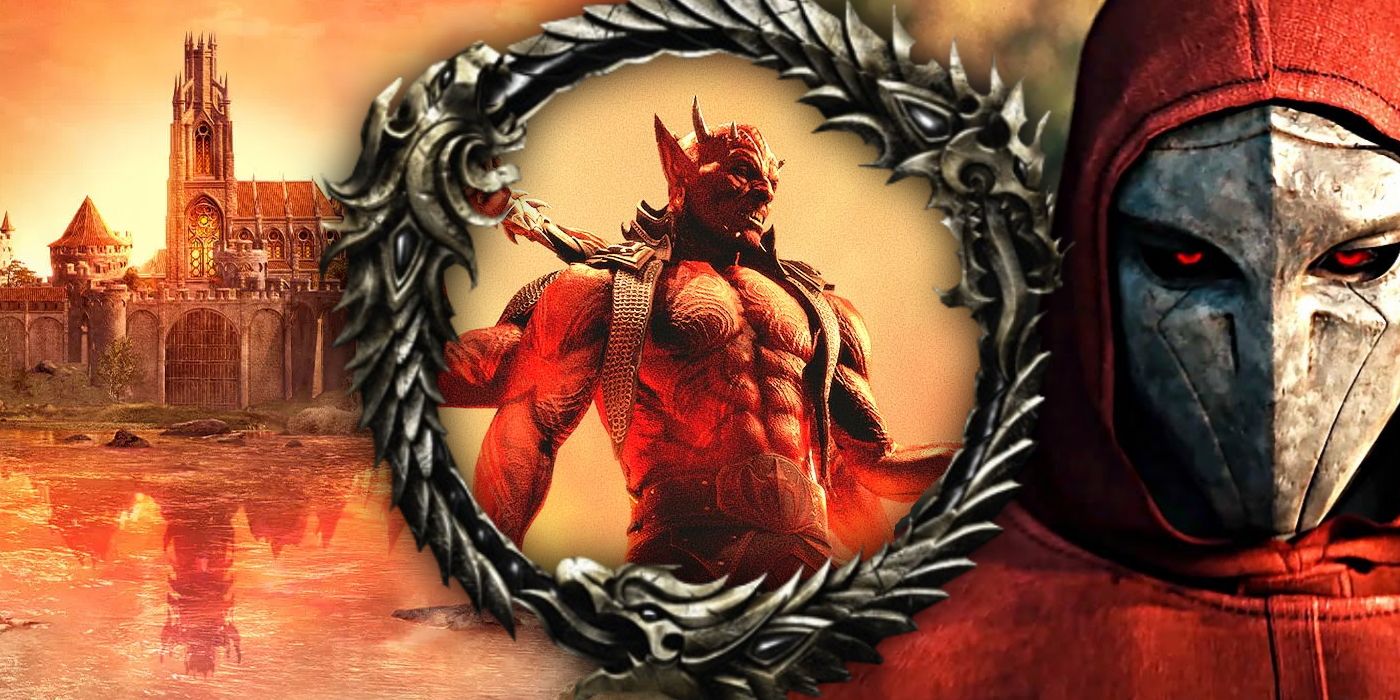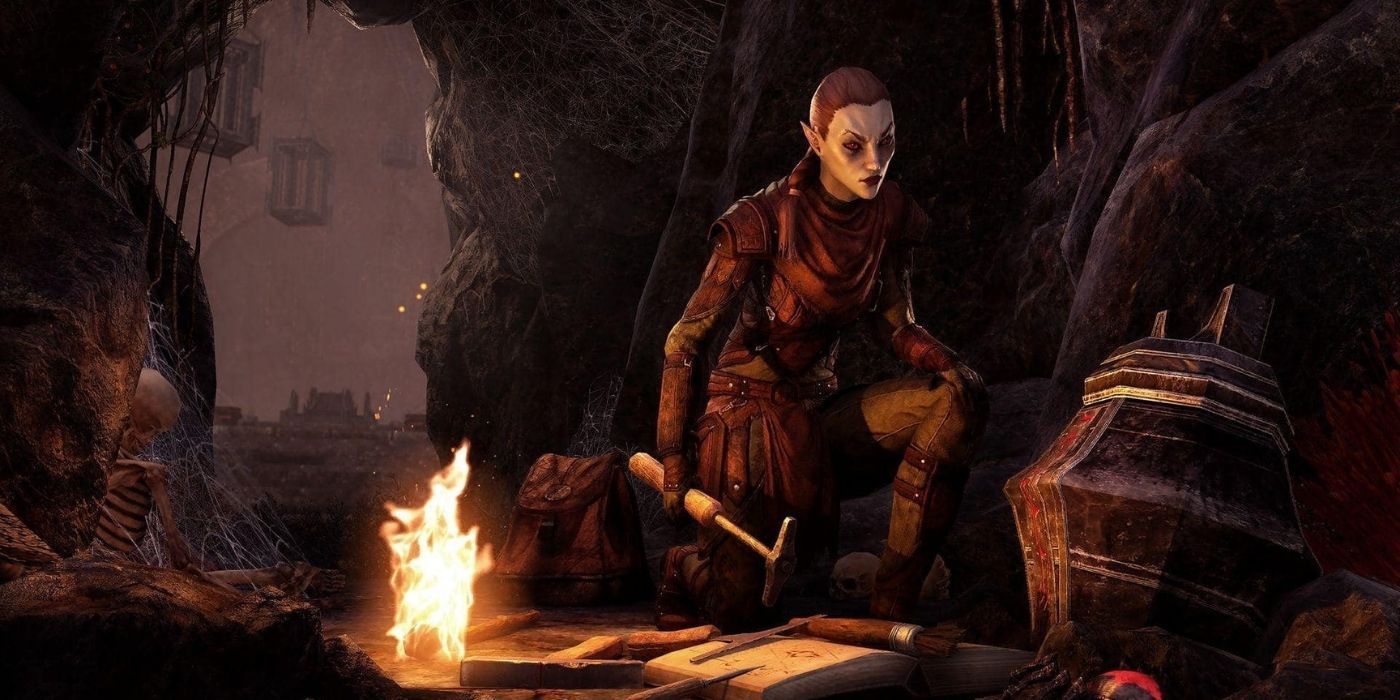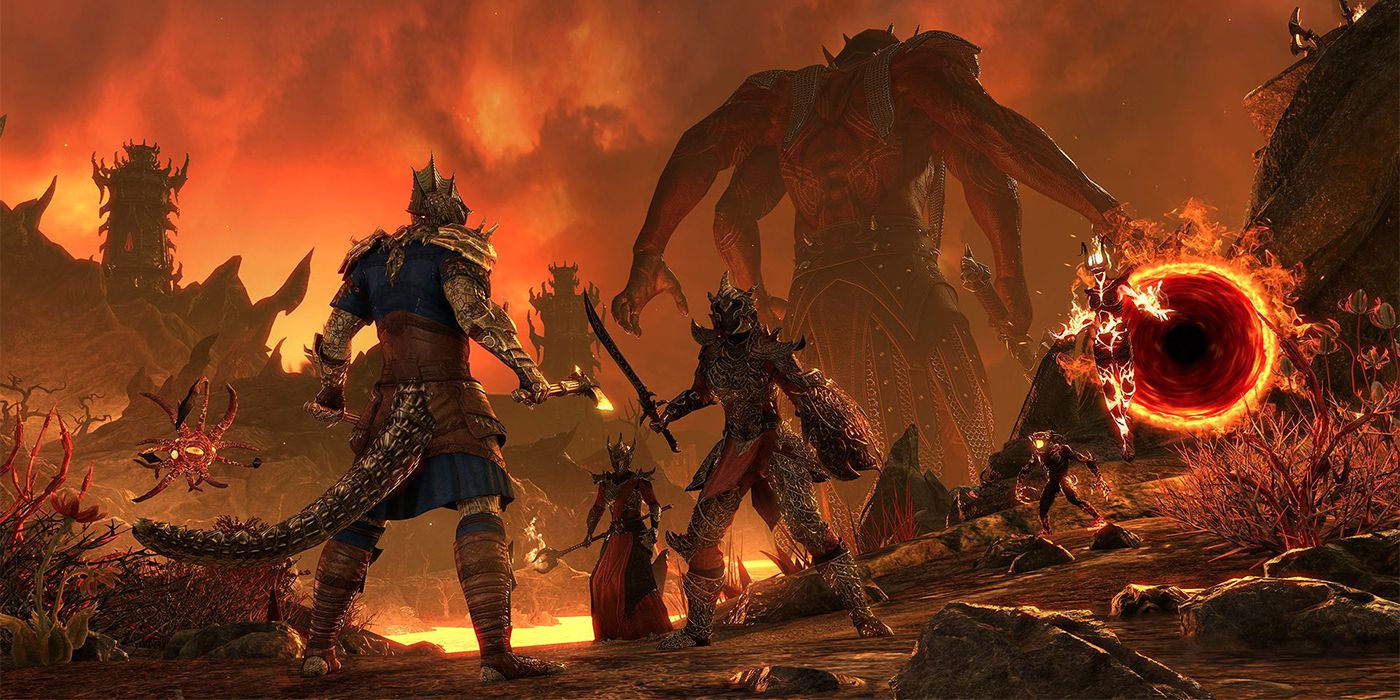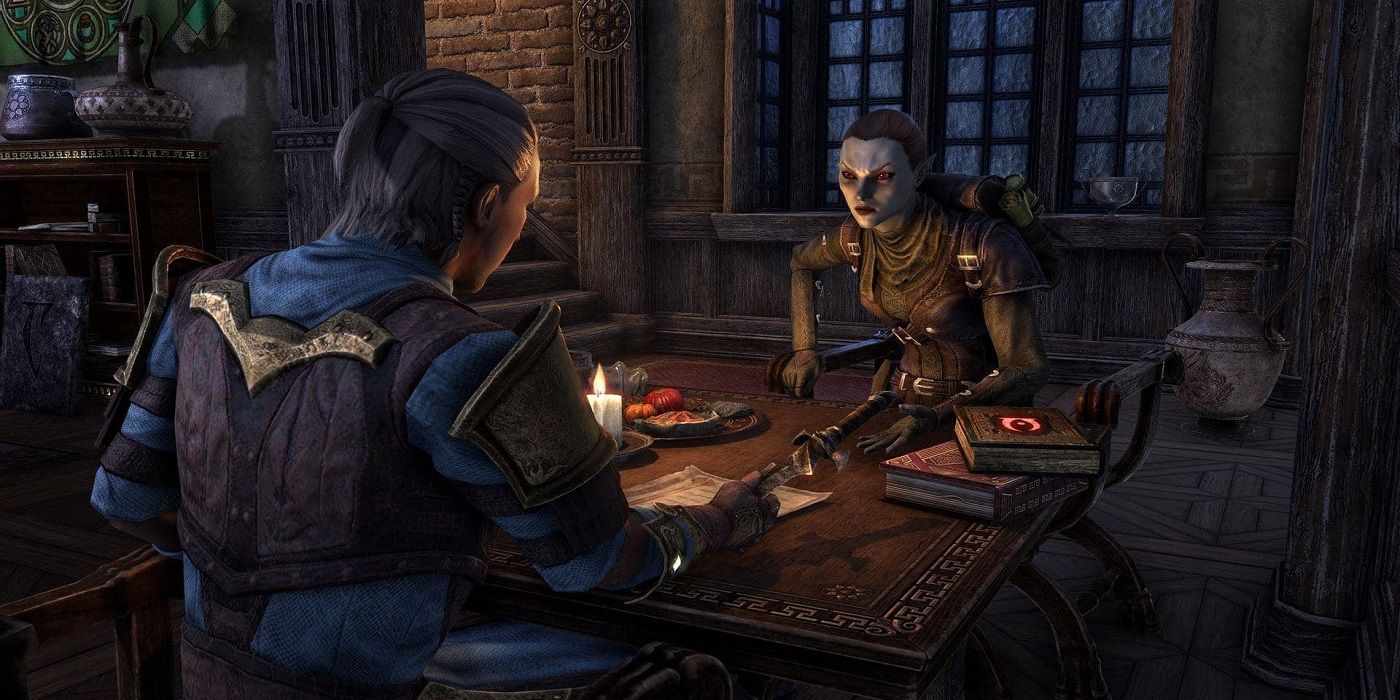
The Elder Scrolls Online has been one of the most successful MMORPGs of the last decade, taking players to Tamriel's Second Era as they fight through both familiar areas and others that have never been seen in the main series. The game has undergone some big changes since its launch, including dropping its subscription fee and opening up every area to all character levels.
The Elder Scrolls Online is developed by Zenimax Online Studios. Game Rant sat down with Matt Firor, the CEO of Zenimax Online Studios, to talk about the game's development, success, and upcoming expansion, Gates of Oblivion. Interview has been edited for clarity and brevity.
RELATED: The Elder Scrolls: Call to Arms ESO Cinematic Hero Minis Now Available
Q: During ESO’s development, breaking into the MMO market was difficult. Games like Star Wars: The Old Republic were showing just how hard it was to turn even the best-known single player RPGs into MMOs. What was it like for Zenimax Online Studios to be given the challenge of creating The Elder Scrolls Online?
A: You could write a whole book about that. The key was finding the right team that had experience doing it. I had been making online games for fifteen years by that point, by 2007, so I had tons of experience doing just that, which is taking an idea and making a massively multiplayer game out of it. The key was finding the things in the IP that resonate with players.

Fortunately with that, Elder Scrolls is pretty much the perfect IP and set-up for a massively multiplayer virtual-world game. Whereas things like Star Wars were amazing worlds, there hadn’t really been massive games based on that IP. But with Oblivion and Skyrim and Morrowind they were what some in the fan-base love to call massively single-player games in the Elder Scrolls series, so it was an easy concept to take the amazing world of Tamriel and add players to it. A lot of the design decisions were more about "what game systems should we have?" and "how should the class system and skill system work?" and not so much "how do we represent races?" and "how do we represent the different provinces?" because that was already pretty set in stone and standard, and that helped us a lot.
Q: World of Warcraft introduced many people to MMOs but it was far from the first. What lesser known MMOs influenced ESO, and are there any influences you think have been particularly vital to its success?
A: I was the producer and one of the designers on Dark Age of Camelot, which was an MMO that came out pre-WoW - it came out in 2001. I had worked on - and many of the core team of ESO back before launch came from - Mythic Entertainment as well. We had experience with that type of game, which was three-faction PvP with a world and story wrapped around it. The world of Tamriel obviously lays out very well in that sense as well.
Camelot had a ton of influence on what we did just because we had experience doing it, but WoW obviously did. Blizzard did a great, great job at taking what was up until then a very hard-to-get-into genre and non-new-player-friendly and a steep learning curve. They took that and made WoW. That was all of those ideas about community and playing with players and an amazing fantasy virtual world, but they made it much easier to get into and understand, which was the thing they did the best, which made it consistent and not quite so hardcore. So, those ideas translated very well to ESO as well. Of course, Star Wars: The Old Republic had come out by that point, and they did really really good storytelling because it was BioWare and that’s what they do.
We really looked at a lot of games, but it wasn’t just MMOs. There were tons of other games that we got great ideas from. Obviously all the Elder Scrolls games, but multiplayer games that weren’t “MMOs” like Grand Theft Auto. It’s a massive online game with millions of people playing it. And we took a lot of ideas from what ended up being our One Tamriel update where we made the world not based on levels so you could play with anyone no matter what level they were.
We got that concept pretty much from GTA, because do you really care what level you are in GTA when you jump into the game? No, not really. You just jump in and play and have fun. We really liked that idea. You could group with anyone any time, and go on adventures, so we got some inspiration from there. It’s not just early MMOs and WoW and Star Wars that had an influence on ESO, it was really a ton of different types of games.
RELATED: The Elder Scrolls 6 Should Bring Back One Oblivion Feature for the Laughs

Q: Fans of the franchise will recognize the Daedric Prince Mehrunes Dagon from Oblivion. What was the driving force behind bringing him back in the upcoming Gates of Oblivion expansion and what will be different this time around?
A: What we do when we set up future chapters is we look at the map and we see unexplored-in-ESO areas, and that area of Tamriel was pretty interesting for a number of reasons. It kind of has some nostalgia value because it’s in Cyrodiil and it has the city of Leyawiin which you remember from Oblivion but it also stretches out across the Niben River into Black Marsh which is the Argonian area which has not been in an Elder Scrolls game since Arena, since 1994.
We liked that area first, and because Leyawiin is there we knew that there was going to be some Oblivion vibes from that. We really hadn’t had Mehrunes Dagon in any of the major stories and so we thought if we’re going to be in area in Cyrodiil and we’re going to have Leyawiin let’s bring Dagon back and do a precursor story to what happened in Oblivion. Because, of course, Elder Scrolls Online takes place about seven-hundred years before Oblivion, so it gives us the chance to do some foretelling and prequel-izing – although we would never call it that – of the story that you then would go on and play in Oblivion.
Q: Gates of Oblivion isn’t the only big update coming to ESO - ESO: Console Enhanced will be released at the same time. What are some of the changes console players can expect in the new edition?
A: ESO: Console Enhance is really the next-gen version of the game so it has all of the bells and whistles you would expect in a next-gen game, especially visually. We take advantage of all of the advances in technology between this console generation and the last one. Its been seven years since then so a lot of technology changes. We decided to go ahead and invest in ESO because so many people are playing the game and we knew that a lot of our console players were going to buy the current-gen consoles.
We did Console Enhanced, and really it does two things. One is you can play in Fidelity Mode where it really looks fantastic it has all of the bells and whistles. Or you can play it on current-gen consoles in Performance Mode which looks fantastic still but runs at 60 frames a second. So, we’re giving players the choice to choose – at least on the PS5 and Xbox Series X - do you want 4K with all the bells and whistles at 30 frames a second, or do you want to scale it back a little bit and play at 60? And on the Series S there’s the equivalent to that just not at 4K.
Q: ESO’s map is ginormous and with the upcoming addition of Blackwood in the Gates of Oblivion expansion it’s about to get even bigger. Do you think ESO will ever take players beyond Tamriel?
A: We do that in a couple of places. In the launch game we went to the Deadric realm of Molag Bal, Coldharbour. We’ve gone to the Daedric worlds a bunch of times. We haven’t gone off the known continent or the islands around it and really we have so much more to explore on the continent of Tamriel as well as the adjacent Planes of Oblivion. For example, with Mehrunes Dagon of course there’s the Deadlands component, and we introduced and we introduced a little bit of Deadlands in our portal events that are coming in Blackwood. I think of it more as exploring more of Tamriel, but also starting to get a little more into the Daedric realms of Oblivion here and there.
Q: The new region Blackwood will bring back Leyawiin from Oblivion. What makes the city different in the Second Era?
A: It’s the same thing that it was in the launch version of ESO where the whole thing takes place 700 years before, where it’s close enough in time that the provinces are the same, the geography is the same, the towns and cities because they’re pretty ancient are generally similar. It feels familiar to players who played the other Elder Scrolls games, the single-player ones, but it’s far enough away in time that we can tell our own stories with our own characters that maybe are the great-great-great-great grandparents of characters that you met in Oblivion or Skyrim.
It’s tangentially related to Oblivion, but it also has this part of Blackwood across the river in Black Marsh and the city of Gideon, which are well known in lore but no-ones ever really been to it except since Arena, which was almost 25 years ago. It’s a cool combination of nostalgia one one side of the map and unknown, interesting new things to explore on the other. It really fits a good mold for us.
RELATED: Bethesda Says Elder Scrolls Online Is Now The Most Popular Multi-Platform MMORPG

Q: Will ESO’s new companions have their own questlines, or is the companion system more focused on combat?
A: A bunch of different systems lined up to make us think that companions would be a great addition to the game. We have a pet system where you can get a pet that follows around behind you and players love that. They’ve always wanted it to be more interactive and have characters instead of just animals following you around. We decided to play with that idea, and of course Skyrim and the Fallout games have the concept of companions that are there for storytelling. They’re not just to keep you company. It gives you another kind of system that you can play with, like you can level your companion, you can go on quests and learn more about your companion, you can put armor and costumes on them and augment your look by the way they look.
Yes, they can follow you around and help you in combat and that’s great, but it also allows you to get invested a little more in the game and the world by having something else that you can customize and make your own. These companions – we’re starting with two of them – they have their own personalities, they have their own quests, they like certain things, they dislike certain things. As you get to know them more and go on some of their quests they open up a little more and tell you a little more about them. They’ll go up in levels, you can get them weapons and armor and costumes, and so it’s just a fun way to interact with the world in a way that you hadn’t done before.
Q: ESO released over seven years ago. What were the most memorable moments on that journey, and what are your hopes for ESO’s future?
A: For me there’s only one moment that stands out above all of them and that’s is the evening – I forget actually what time of day it was because time was not relevant at that point – but when we first opened the servers to real players on day one of the game’s launch. I actually sat my character in the middle of Daggerfall city and just watched players come in from the newbie zones, and went into the newbie zones too and just sat and watched as they poured through all in their level 3 costumes right out the Wailing Prison which was our tutorial back then. Just seeing that happen and seeing players wash over the world that you had been working so hard to create for the last seven years, that was the moment, as a game creator that’s what you live for. The feeling in indescribable. Finally, you get to share what you’ve done with the world, and seeing people actually do it is a very very very cool moment.
As for my hopes for ESO’s future, I think it’s pretty much keep doing what we’re doing. We’re listening to the community. A lot of the features that go into the game are based on community feedback. We have a fantastic community in the game, we really do. They are without a doubt the most accepting, ready-to-help-new-players community that I’ve ever seen in gaming. We’ve listened to them a lot, keep adding great content. Certainly with Console Enhanced the game is gonna look fantastic all through this generation of consoles. It looks great on PC too. So, I think it’s adding more great content, telling more great stories, allowing players to explore more of Tamriel, and just keep our eye on making players happy and ensuring that they can associate with one another and group with one another and have fun doing it. We do all those things, and ESO will be around for a long time to come.
[END]
The Elder Scrolls Online: Blackwood launches June 1 for PC and Stadia; and June 8 for PS4, PS5, Xbox One, and Xbox Series X/S.
MORE: Elder Scrolls Online: 10 Best Dragonknight Builds, Ranked

